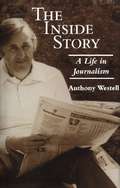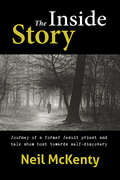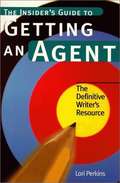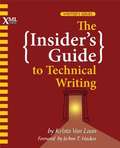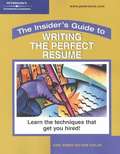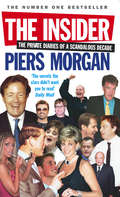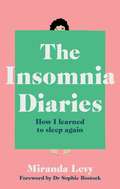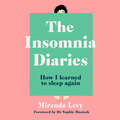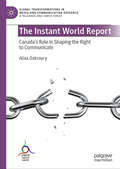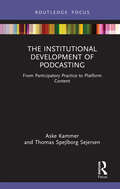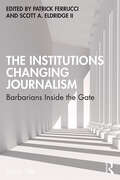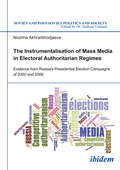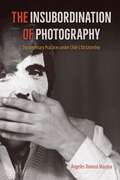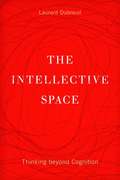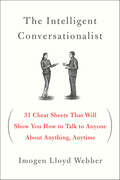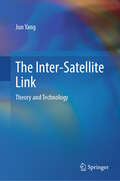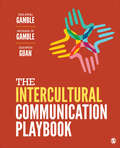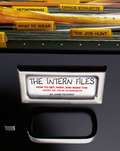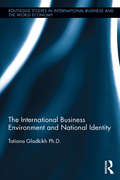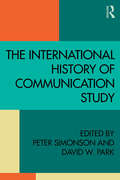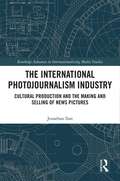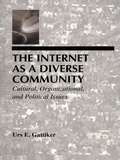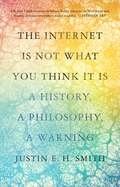- Table View
- List View
The Inside Story: A Life in Journalism
by Anthony WestellFor political buffs, this is a fascinating view of the politics of the Diefenbaker-Pearson-Trudeau era, including backroom information never before published. For media buffs, its an inside view of the politics of our leading newspapers, and a critical analysis of modern journalism by one who helped to invent it. For those concerned with the great public issues of our times, it’s a controversial account of where constitutional reform went wrong and of how we got to free trade by a journalist who played a significant role in the national debate. But this is more than the record of a professional life. It’s also the personal story of a motherless boy growing up in Britain, his wartime experiences with the Royal Navy, and his decision to emigrate to Canada, with a young family in tow, after publisher Lord Beaverbrook declared the young scribe unfit for promotion because he was the wrong shape: "Small head, big feet, won’t do."
The Inside Story: Journey of a former Jesuit priest and talk show host towards self-discovery
by Neil MckentyA book for anyone on the journey to wholeness. A story of toxic religion, sex and celibacy, drinking and depression, and how they led towards self-discovery and spiritual awakening. “A compelling testimony to our capacity for spiritual transformation in the face of overwhelming odds. McKenty’s story is both inspirational and gut-wrenchingly honest. Highly recommended.” - Tom Harpur, Syndicated Columnist and Bestselling Author
The Insider's Guide to Getting an Agent
by Lori PerkinsPerkins delivers all the vital information on how to get the best representation for your work- the latest trends, how to target the right agents, potential of subrights, publicity and foreign sales and when it's time to make writing your day job.
The Insider's Guide to Technical Writing
by Krista Van LaanEvery complex product needs to be explained to its users, and technical writers, also known as technical communicators, are the ones who do that job. A growing field, technical writing requires multiple skills, including an understanding of technology, writing ability, and great people skills. Whether you're thinking of becoming a technical writer, just starting out, or you've been working for a while and feel the need to take your skills to the next level, The Insider's Guide to Technical Writing can help you be a successful technical writer and build a satisfying career. Inside the Book Is This Job for Me? What does it take to be a technical writer? Building the Foundation: What skills and tools do you need to get started? The Best Laid Plans: How do you create a schedule that won't make you go crazy? How do you manage different development processes, including Agile methodologies? On the Job: What does it take to walk into a job and be productive right away? The Tech Writer Toolkit: How do you create style guides, indexes, templates and layouts? How do you manage localization and translation and all the other non-writing parts of the job? I Love My Job: How do you handle the ups and downs of being a technical writer? Appendixes: References to websites, books, and other resources to keep you learning. Index
The Insider's Guide to Writing the Perfect Resume
by Karl Weber Rob KaplanIn this easy-to-follow handbook, two veteran job seekers offer straightforward and step-by-step advice that helps readers focus on their strengths and develop an eye-catching resume to get the job they want. Includes timely information on salaries, job trends, and top companies.
The Insider: The Private Diaries of a Scandalous Decade
by Piers MorganThe Insider dominated the media on publication in March 2005 and instantly became a No.1 bestseller. Not only did it fill thousands of column inches with its revelations about prominent political and showbiz figures, it was critically acclaimed across the broadsheets for its unique and fascinating insight into the worlds of celebrity, royalty, politics and the media.Piers Morgan was made editor of the News of the World, the UK's biggest-selling Sunday newspaper at the record-breaking age of 28. The decade that followed was one of the most tumultuous in modern times. In a world of indiscreet dinners, private meetings and gossipy lunches, Piers Morgan found himself in the thick of it. His diaries from this remarkable period reveal astonishing and hilarious encounters with an endless list of celebrities and politicians alike: Diana, William, Charles and Camilla; Tony Blair, Cherie, Gordon Brown; Paul McCartney, George Michael and Elton John; Jeremy Clarkson, Paula Yates and Gazza to name just a few.Entertaining, engaging and compulsive, The Insider was the most talked-about book of 2005, blowing apart every notion we have of politics, media and celebrity.
The Insomnia Diaries: How I learned to sleep again
by Miranda LevyA Financial Times readers' best 2021 summer book'A powerful new book' - The Daily Mail'Quite the story... fascinating' - Claire Byrne, RTE1'This memoir meets manual with expert tips is both honest and helpful' - Victoria Woodhall, Get the GlossFOREWORD BY DR SOPHIE BOSTOCK'29th June 0 HOURS, 0 MINUTES Eleven forty-seven pm. A door slams as the neighbour's teenage son comes home from the pub. An hour later, the last Tube rumbles past and I thump my pillow over to find a cool spot. I refuse to open the window because of my fear of hearing the first bird of morning, confirmation that the next day is about to start and I have failed, yet again. Failed in my quest to sleep, which one would think is a basic human right.But I am not a POW whose captors breach the Geneva Convention. No one has stolen my sleep from me. I am not wired up to electrodes, a neon light is not shining in my face all night long. I have blackout blinds and a king-size bed all to myself. My enemies are my brain and a body that has forgotten how to shut down.'After a single, catastrophic event, journalist Miranda Levy had one sleepless night, then another, and then another. She sought help from anyone she could: doctors, a therapist, an acupuncturist, a hypnotist, a reiki practitioner and a personal trainer - but nothing seemed to work.Sleep, wellbeing and mental health are intrinsically linked. Yet sleeplessness is surprisingly common: 16 million of us suffer from insomnia, and the sleep industry is worth £100 billion (Daily Mail). In The Insomnia Diaries, Miranda Levy tells the story of her experience of severe, disabling insomnia that affected every aspect of her life for years, and how she ultimately recovered. Part memoir, part reportage, this book will help anyone who struggles to get a good night's sleep - whether occasionally or all of the time - appreciate the issues and understand the options as they find their best way to get the rest they need. Dr Sophie Bostock, scientist, sleep expert and member of the team who developed the award-winning digital programme Sleepio, contributes a foreword. She and a host of expert contributors have advised on the medical elements within the text throughout.
The Insomnia Diaries: How I learned to sleep again
by Miranda LevyAfter a single, catastrophic event, journalist Miranda Levy had one sleepless night, then another, and then another. She sought help from anyone she could: doctors, acupuncturists, reiki practitioners, hypnotists, therapists, personal trainers - but nothing seemed to work.Sleep, wellbeing and mental health are intrinsically linked. Yet sleeplessness is surprisingly common: 16 million of us suffer from insomnia, and the sleep industry is worth £100 billion (Daily Mail).In The Insomnia Diaries, Miranda Levy tells the story of her experience of severe, crippling insomnia that affected every aspect of her life for years, and how she ultimately recovered. Part memoir, part reportage, this book will help anyone who struggles to get a good night's sleep - whether occasionally or all of the time - appreciate the issues and understand the options as they find their best way to get the rest they need. Dr Sophie Bostock, scientist, sleep expert and member of the team who developed the award-winning digital programme Sleepio, contributes a foreword. She and a host of expert contributors have advised on the medical elements within the text throughout.(p) 2020 Octopus Publishing Group
The Instant World Report: Canada's Role in Shaping the Right to Communicate (Global Transformations in Media and Communication Research - A Palgrave and IAMCR Series)
by Aliaa DakrouryThis book proposal focuses on Canada's pioneering role in shaping the international understanding of the right to communicate, particularly through the Canadian Telecommission Studies of 1969. The study argues that the 1971 Instant World report, a landmark document, has been overlooked in the existing literature despite its importance in the history of conceptualizing and implementing this human right. The project aims to fill this gap by exploring the historical context of the report and analyzing its contents, shedding light on themes like privacy and indigenous communication rights. Additionally, the manuscript highlights the unique contribution of Betty Zimmerman, the only female Canadian member of the MacBride Commission in 1977, replacing Marshall McLuhan. Zimmerman's insights become pertinent not only for scholars interested in the New World Information and Communication Order but also for feminist studies, showcasing a leading female figure's role in Canadian communication and cultural policy. The research promises a novel and untold perspective on the history of the right to communicate, addressing gaps in international and Canadian communication, women’s studies, and media policy literature.
The Institutional Development of Podcasting: From Participatory Practice to Platform Content (Disruptions)
by Aske Kammer Thomas Spejlborg SejersenReferring back to the early 2000s, this book traces the development of podcasting from a “do-it-yourself” medium by amateurs into its current environment, where a wide variety of individuals, organizations, and platforms operate in an increasingly crowded and competitive market.Through original case studies of shows and platforms including "The Daily" and Spotify, the authors explore the processes and effects of commercialization, platformization, and datafication in the industry. Drawing on institutional theory and the growing body of scholarly literature about podcasting, they examine the shifts and reorientations in institutional logics that characterize podcasting and present the different types of actors that operate in the commercial and noncommercial podcast markets.The Institutional Development of Podcasting will be of interest to advanced students and researchers of audio media, journalism, and media industries.
The Institutions Changing Journalism: Barbarians Inside the Gate
by Patrick FerrucciBringing together original contributions from a worldwide group of scholars, this book critically explores the changing role and influence of institutions in the production of news. Drawing from a diverse set of disciplinary and theoretical backgrounds, research paradigms and perspectives, and methodologies, each chapter explores different institutions currently impacting journalism, including government bodies, businesses, technological platforms, and civic organisations. Together they outline how cracks in the autonomy of the journalism industry have allowed for other types of organizations to exert influence over the manner in which journalism is produced, funded, experienced and even conceptualized. Ultimately, this collective work argues for increased research on the impact of outside influences on journalism, while providing a roadmap for future research within journalism studies. The Institutions Changing Journalism is an invaluable contribution to the field of journalism, media, and communication studies, and will be of interest to scholars and practitioners alike who want to stay up to date with fundamental institutional changes facing in the industry.
The Instrumentalisation of Mass Media in Electoral Authoritarian Regimes: Evidence from Russia's Presidential Election Campaigns of 2000 and 2008 (Soviet and Post-Soviet Politics and Society #164)
by Nozima AkhrarkhodjaevaFocusing on the case of Russia during Putin's first two presidential terms, this book examines media manipulation strategies in electoral authoritarian regimes. Which instruments and approaches do incumbent elites employ to skew media coverage in favor of their preferred candidate in a presidential election? What effects do these strategies have on news content? Based on two case studies of the presidential election campaigns in Russia in 2000 and in 2008, this investigation identifies the critical internal mechanisms according to which these regimes work.Looking at the same country while it transformed from a competitive into a hegemonic authoritarian regime, allows a diachronic comparison of these two regime types. The book explicates the subtle differences between competitive and hegemonic regimes, different types of media manipulation strategies, the diverging extent of media instrumentalization, various interactions among state actors, large business owners, the media, and journalists, the respective effects that all these factors and interactions have on media content, and the peculiar types of bias prevalent in each type of regime. This deep exploration of post-Soviet politics is based on extensive review of documents, interviews with media professionals, and quantitative as well as qualitative content analyses of news media during two Russian presidential election campaigns.
The Insubordination of Photography: Documentary Practices under Chile's Dictatorship (Reframing Media, Technology, and Culture in Latin/o America)
by Ángeles Donoso MacayaLatin American Studies Association Visual Culture Section Best Book PrizeLatin American Studies Association Historia Reciente y Memoria Section Best Book PrizeThe role of documentary photography in exposing and protesting the crimes of a dictatorship After Augusto Pinochet rose to power in Chile in 1973, his government abducted, abused, and executed thousands of his political opponents. The Insubordination of Photography is the first book to analyze how various collectives, organizations, and independent media used photography to expose and protest the crimes of Pinochet’s authoritarian regime. Ángeles Donoso Macaya discusses the ways human rights groups such as the Vicariate of Solidarity used portraits of missing persons in order to make forced disappearances visible. She also calls attention to forensic photographs that served as incriminating evidence of government killings in the landmark Lonquén case. Donoso Macaya argues that the field of documentary photography in Chile was challenged and shaped by the precariousness of the nation’s politics and economics and shows how photojournalists found creative ways to challenge limitations imposed on the freedom of the press.In a culture saturated by disinformation and cover-ups and restricted by repression and censorship, photography became an essential tool to bring the truth to light. Featuring never-before-seen photographs and other archival material, this book reflects on the integral role of images in public memory and issues of reparation and justice. A volume in the series Reframing Media, Technology, and Culture in Latin/o America, edited by Héctor Fernández L’Hoeste and Juan Carlos Rodríguez Publication of the paperback edition made possible by a Sustaining the Humanities through the American Rescue Plan grant from the National Endowment for the Humanities.
The Intellective Space: Thinking beyond Cognition
by Laurent DubreuilThe Intellective Space explores the nature and limits of thought. It celebrates the poetic virtues of language and the creative imperfections of our animal minds while pleading for a renewal of the humanities that is grounded in a study of the sciences.
The Intelligent Conversationalist: 31 Cheat Sheets That Will Show You How to Talk to Anyone About Anything, Anytime
by Imogen Lloyd Webber“Gives readers the background and resources they need to effectively discuss a range of issues . . . as practical as it is hilarious.” —BustleHave you ever been at a cocktail party when all of a sudden you feel like an outsider in the conversation because you have absolutely no idea what the person is talking about? You’re standing around with a glass of wine and someone starts talking about how the stock market did that day leading to the career highs of Ben Bernanke and the best way to short a stock. You stand there completely silent because you know nothing about the stock market, let alone the history of economics. You’re being pushed to the outside edge of the pack and there’s no way to reach gracefully for your iPhone and Google. Fear not: Imogen Lloyd Webber is on a mission to make everyone as conversationally nimble as she has learned to be as a cable news pundit. Her solution: get a few cheat sheets and study up. Remember cheat sheets, those slips of paper filled with facts? As Imogen might say “Google is good, but a cheat sheet is forever . . . ” In eight cheat sheets, Imogen takes you through the facts that come up in most conversations: the English language, math/economics, religion, history, politics, geography, biology and culture. From the history of money to who signed The Magna Carta, Imogen shows you how to get back in a conversation, win any argument and most importantly, how to pivot out of a tough conversational bind. Imogen Lloyd Webber’s The Intelligent Conversationalist will help you talk with anyone about anything anytime.
The Inter-Satellite Link: Theory and Technology
by Jun YangThis book highlights a comprehensive coverage of the science and technology of multi-orbit inter-satellite links. It describes the fundamental concepts and system requirements, presents the architecture and measurement principles and demonstrates the anti-interference design, access and slot planning, network transmission and routing, calibration and test evaluation, as well as applications for measurement and communication. Recent advances in theoretical research on precision measurement and communication are presented. The book serves as a reference for professionals involved in designing space-based information systems or developing satellite-ground equipment or services based on inter-satellite links. Additionally, it is also a valuable resource for teachers and graduate students in related majors.
The Intercultural Communication Playbook
by Teri Kwal Gamble Michael W. Gamble Xiaowen GuanFeaturing a three-prong approach on culture, communication, and creative problem solving, The Intercultural Communication Playbook, with its unique, user-friendly layout and presentation, highlights how active, imaginative, and productive problem-solving methods can transform the way students understand intercultural communication. This framework from authors Teri Kwal Gamble, Michael W. Gamble, and Xiaowen Guan guides learners to understand their intercultural identity, broaden their worldview, and successfully improve their communication in real-world settings. Each chapter features exercises that encourage students to diversify their everyday thinking, individually examine their personal preferences, eliminate mental barriers, and discover innovative solutions to intercultural communication challenges.
The Intercultural Communication Playbook
by Teri Kwal Gamble Michael W. Gamble Xiaowen GuanFeaturing a three-prong approach on culture, communication, and creative problem solving, The Intercultural Communication Playbook, with its unique, user-friendly layout and presentation, highlights how active, imaginative, and productive problem-solving methods can transform the way students understand intercultural communication. This framework from authors Teri Kwal Gamble, Michael W. Gamble, and Xiaowen Guan guides learners to understand their intercultural identity, broaden their worldview, and successfully improve their communication in real-world settings. Each chapter features exercises that encourage students to diversify their everyday thinking, individually examine their personal preferences, eliminate mental barriers, and discover innovative solutions to intercultural communication challenges.
The Intern Files
by Jamie Fedorko Dwight AllottIn today's highly competitive job market, an internship at the right company can be the first step to building a career. But how do you get the gig of your dreams? And once in the door, how do you figure out what to wear, whether it's okay to hook up with a coworker, and how to suck it up when you're smarter than your boss?
The International Business Environment and National Identity (Routledge Studies in International Business and the World Economy)
by Tatiana GladkikhGlobalisation influences every aspect of post-modern social reality. However, little empirical research has considered how globalisation affects people’s perception of their national attachments. This book explores the nature of national identity in our increasingly globalised society. "Who Are You?" is the question that it addressed in conversations with international business travellers whose exposure to different cultures, languages and values through their business travel and interactions with their foreign colleagues brings a new slant on their vision of the world. How does it influence their understanding of themselves? The International Business Environment and National Identity is based on interviews with Russian and British business travellers whose views on their national identity and the role of global business in shaping it offer a new insight on our understanding of the impact of global forces on contemporary society. The book discusses the respondents’ practical experiences of their international encounters, their impact on shaping their personal identification and highlights differences and similarities in people’s articulation of their national belonging. The issues of understanding the self and the effects of globalisation on business people’s professional and personal lives are at the core of the book’s investigation. The International Business Environment and National Identity will appeal to students and researchers of international management and cross cultural management as well as those studying intercultural communication and globalisation.
The International Distribution of News
by Jonathan Silberstein-LoebBased on newly available and extensive archival evidence, this book traces the history of international news agencies and associations around the world from 1848 to 1947. Jonathan Silberstein-Loeb argues that newspaper publishers formed news associations and patronized news agencies to cut the costs of news collection and exclude competitors from gaining access to the news. In this way, cooperation facilitated the distribution of news. The extent to which state regulation permitted cooperation, or prohibited exclusivity, determined the benefit newspaper publishers derived from these organizations. This book revises our understanding of the operation and organization of the Associated Press, the BBC, the Press Association, Reuters, and the United Press. It also sheds light on the history of competition policy respecting the press, intellectual property, and the regulation of telecommunications.
The International History of Communication Study
by Peter Simonson David W. ParkThe International History of Communication Study maps the growth of media and communication studies around the world. Drawing out transnational flows of ideas, institutions, publications, and people, it offers the most comprehensive picture to date of the global history of communication research and education. This volume reaches into national and regional areas that have not received much attention in the scholarship until now, including Asia, Latin America, Africa, and the Middle East alongside Europe and North America. It also covers communication study outside of academic settings: in international organizations like UNESCO, and among commercial and civic groups. It moves beyond the traditional canon to cover work by forgotten figures, including women scholars in the field and those outside of the United States and Europe, and it situates them all within the broader geopolitical, institutional, and intellectual landscapes that have shaped communication study globally. Intended for scholars and graduate students in communication, media studies, and journalism, this volume pushes the history of communication study in new directions by taking an aggressively international and comparative perspective on the historiography of the field. Methodologically and conceptually, the volume breaks new ground in bringing comparative, transnational, and global frames to bear, and puts under the spotlight what has heretofore only lingered in the penumbra of the history of communication study.
The International Photojournalism Industry: Cultural Production and the Making and Selling of News Pictures (Routledge Advances in Internationalizing Media Studies)
by Jonathan IlanHow are events turned into news pictures that define them for the audience? How do events become commodified into pictures that both capture them and reiterate the values of the agencies that sell them? This book looks at every stage of the production of news photographs as they move to and from the ground and are sold around the world. Based on extensive fieldwork at a leading international news agency that includes participant observation with photographers in the field, at the agency’s local and global picture desks in Israel, Singapore, and the UK, in-depth interviews with pictures professionals, and observations and in-depth interviews at The Guardian’s picture desk in London, the findings in this book point to a wide cultural production infrastructure hidden from – and yet also nurtured and thus very much determined by – the consumer’s eye.
The Internet As A Diverse Community: Cultural, Organizational, and Political Issues (LEA Telecommunications Series)
by Urs E. GattikerIn this volume, author Urs Gattiker offers a broad overview of Internet and technology-related theory. He examines Internet and multimedia issues from an international perspective, outlining issues of international sovereignty and the potential impact of national interests on global technology policy. He also surveys the issues of regulation and institutionalization of the Internet, examines ways for reducing the inequality of benefits from such technology, and explores the opportunities and challenges the Internet offers for consumers, firms, governments, and interest groups. In assembling this treatise, Gattiker synthesizes a vast body of literature from communication, economics, philosophy, political science, management, psychology, science policy, telecommunication engineering, and other areas. The Internet as a Diverse Community provides readers with a framework for analyzing and selecting between many different Internet choices. It explores issues from a social-impact perspective, using examples from a variety of contexts and firms around the world. The work also offers a wealth of new social theory on such topics as moral and ethical issues and the opportunities, choices, and challenges the Internet offers for consumers, investors, managers, and public policy decision makers. It examines the current and future challenges that computer-mediated technologies present, and sets forth new theoretical perspectives on such areas as multimedia and the profit-maximizing firm; the Internet and the private user; managing multimedia productively; and the social and moral costs of various Internet options and choices. Taken as a whole, this resource provides valuable insights on the Internet and is essential reading for business, telecommunication, public policy, and technology decision makers around the globe.
The Internet Is Not What You Think It Is: A History, a Philosophy, a Warning
by Justin E. SmithAn original deep history of the internet that tells the story of the centuries-old utopian dreams behind it—and explains why they have died todayMany think of the internet as an unprecedented and overwhelmingly positive achievement of modern human technology. But is it? In The Internet Is Not What You Think It Is, Justin Smith offers an original deep history of the internet, from the ancient to the modern world—uncovering its surprising origins in nature and centuries-old dreams of radically improving human life by outsourcing thinking to machines and communicating across vast distances. Yet, despite the internet’s continuing potential, Smith argues, the utopian hopes behind it have finally died today, killed by the harsh realities of social media, the global information economy, and the attention-destroying nature of networked technology.Ranging over centuries of the history and philosophy of science and technology, Smith shows how the “internet” has been with us much longer than we usually think. He draws fascinating connections between internet user experience, artificial intelligence, the invention of the printing press, communication between trees, and the origins of computing in the machine-driven looms of the silk industry. At the same time, he reveals how the internet’s organic structure and development root it in the natural world in unexpected ways that challenge efforts to draw an easy line between technology and nature.Combining the sweep of intellectual history with the incisiveness of philosophy, The Internet Is Not What You Think It Is cuts through our daily digital lives to give a clear-sighted picture of what the internet is, where it came from, and where it might be taking us in the coming decades.
